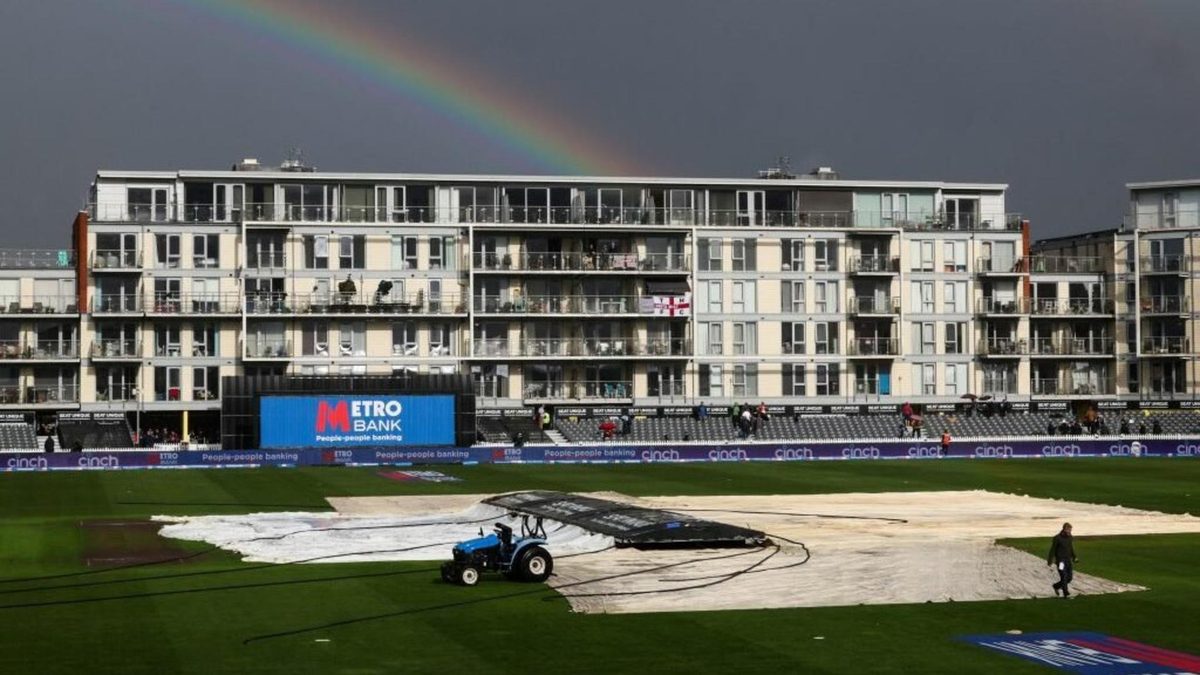
The third and final England-Ireland ODI was abandoned after a brief but heavy downpour in Bristol, with officials calling off the game just 33 minutes after players were brought off the field and before the sun shone over the County Ground for the remainder of the afternoon.
Play was halted shortly after the dismissal of Sam Hain at the end of the 31st over with England on track for a colossal first-innings total. Earlier in the day, Phil Salt was responsible for record-equalling first over of the game before Ben Duckett scored an unbeaten 72-ball century from No. 4.
But the fall of Hain also marked the end of the international summer as the umpires called off play a mere 33 minutes after the first raindrop fell in Bristol.
The groundstaff were slow to cover the playing area. By the time they were able to reach the pitch, the strength of the wind and the velocity of the rain made covering the pitch and the surrounding areas extremely difficult.
The pitch itself was not immediately covered while the run-up area to the Ashley Down Road end part of the ground wasn’t protected for at least 10 minutes after the players were ushered off the ground. The umpires required only a cursory inspection of the pitch before calling the game off.
For the spectators it was doubly frustrating. As 31 overs were bowled, they were not entitled to any form of refund – the maximum number of overs that sees refunds distributed for an ODI in England is 30.
The offending shower was also telegraphed for much of the day and was only ever forecast to last between 30 and 45 minutes. It was unfortunate, given the forecast and the break in play that followed the dismissal of Hain, that the covers were not brought on before the heavens opened. However, even if the covers had been brought on more hastily, there is no guarantee that play would have been possible given the rain that fell in the day leading up to the final home England international of the summer.
Overnight rain undoubtedly played a part in the speed of the cancellation; both captains Zak Crawley and Paul Stirling acknowledged that the ground was damp before the start of play. Any further significant rainfall was always going to threaten the likelihood of a result. Crawley also explained that while it is rare to see conditions deteriorate so quickly to render a playing area as unplayable, it is not unheard of to see scenarios like this to play out in late September when there has been rain and surfaces take longer to dry.
The wider context around the fixture is perhaps instructive. This is only the fifth time since 2000 that international men’s cricket has been played in England past September 20 with Bristol, which has hosted eight England internationals over the last decade, set to host an England-Australia ODI as late as September 29 in 2024, the joint-latest England will have hosted an international this century. This is the fourth men’s ODI in succession that Bristol has had an abandonment – two during the 2019 World Cup and one against Sri Lanka in 2021.
The facilities at Bristol are also not on the same level as many of the other venues that host international cricket in England. For one, there is no hover craft and two, the size of the groundstaff is between 12 and 15 for an international fixture – the Oval, for instance, would generally have at least 20 staff working on an international fixture.
Speaking after the fixture’s cancellation, Gloucestershire chief executive Will Brown said: “We’d love a hover cover, I think every ground in the country would but there is a reality there that we’ve seen them break down as well. We’d always double or triple our groundstaff for games like this.”
When asked if he thought his ground staff were slow to react to the rain, he said: “It’s hard to tell. The conditions last night were shocking and those covers are going to be wet and heavy as well, then you’ve got to bear in mind the conditions people were trying to move them in. They did an admirable job in very difficult circumstances.
“I hate to say it but it worries me greatly that it could be a sign of things to come. We’ve got lots of cricket being played in September next year and with climate change, we’ve seen heavy rain in June and July. The game needs to be thinking innovatively around how we get games on or prepare pitches or surfaces using different things to make sure we get cricket away.”








